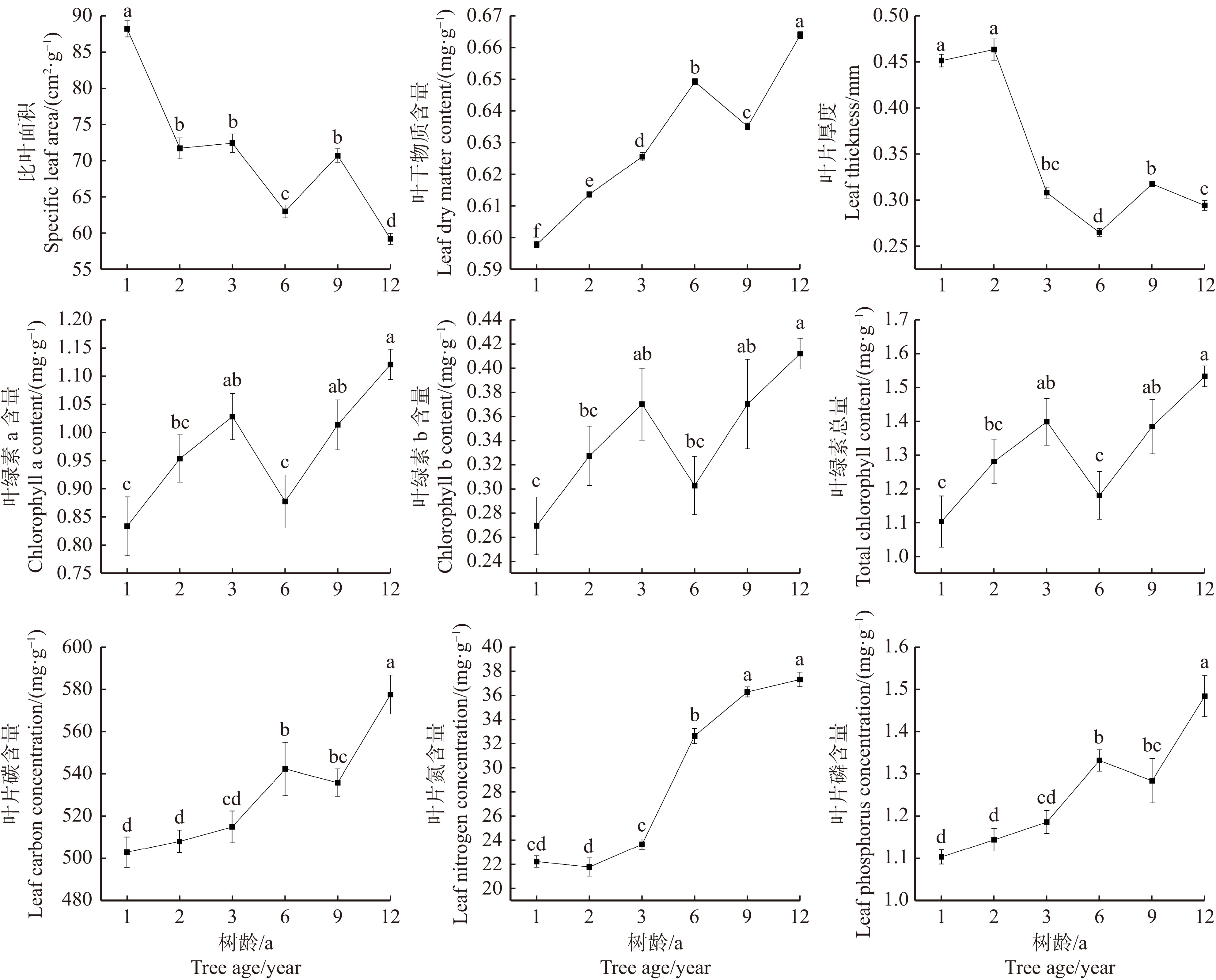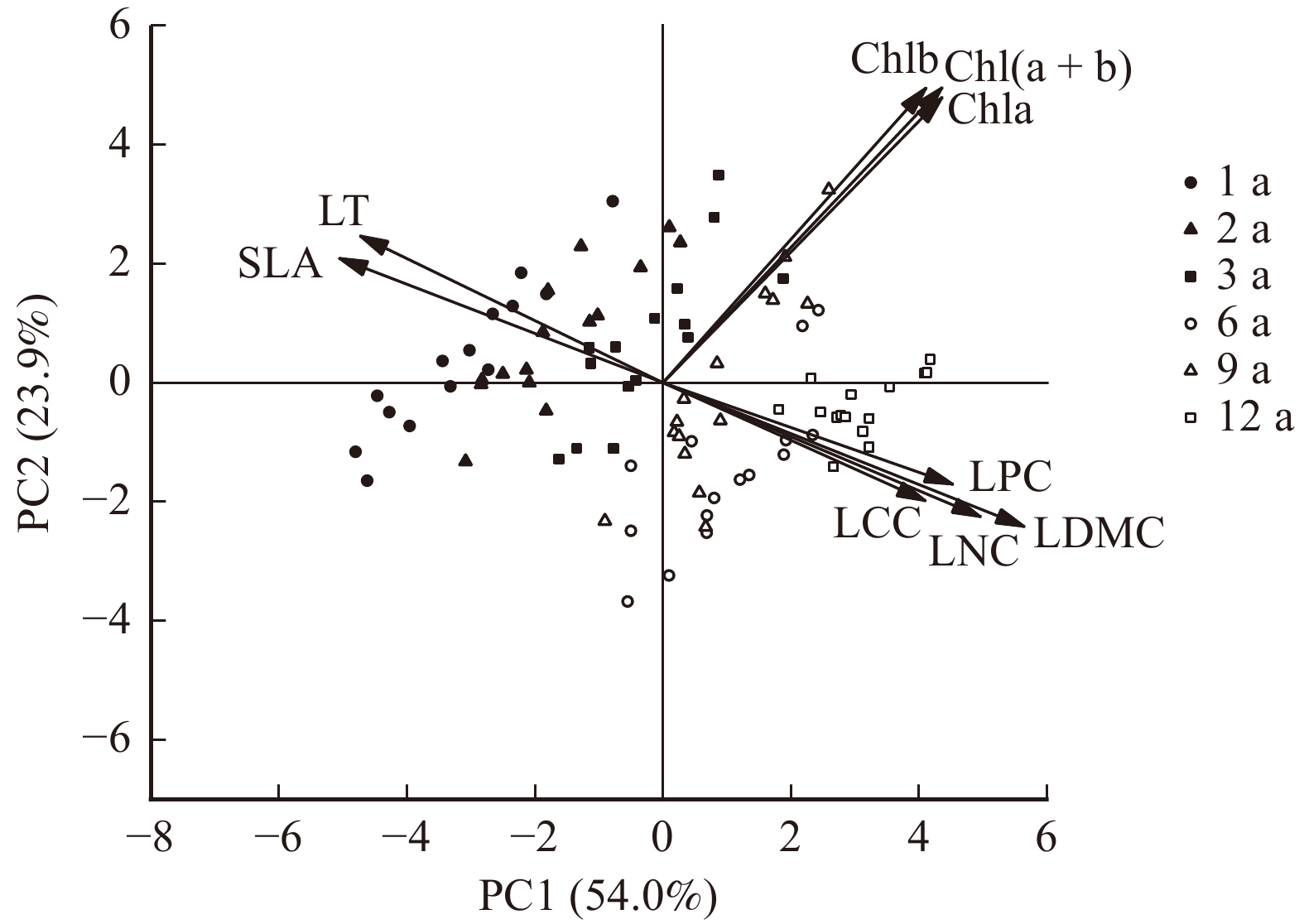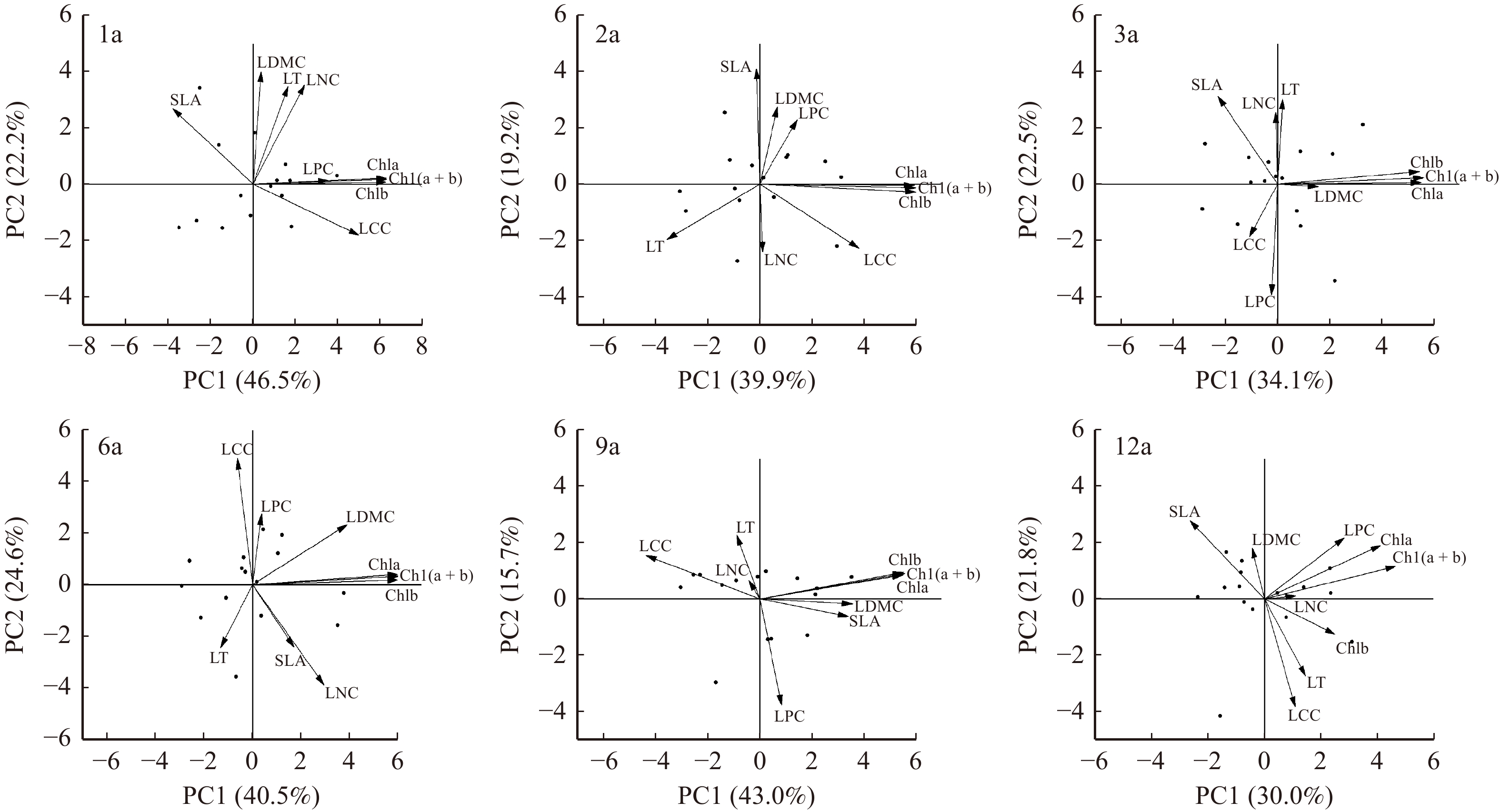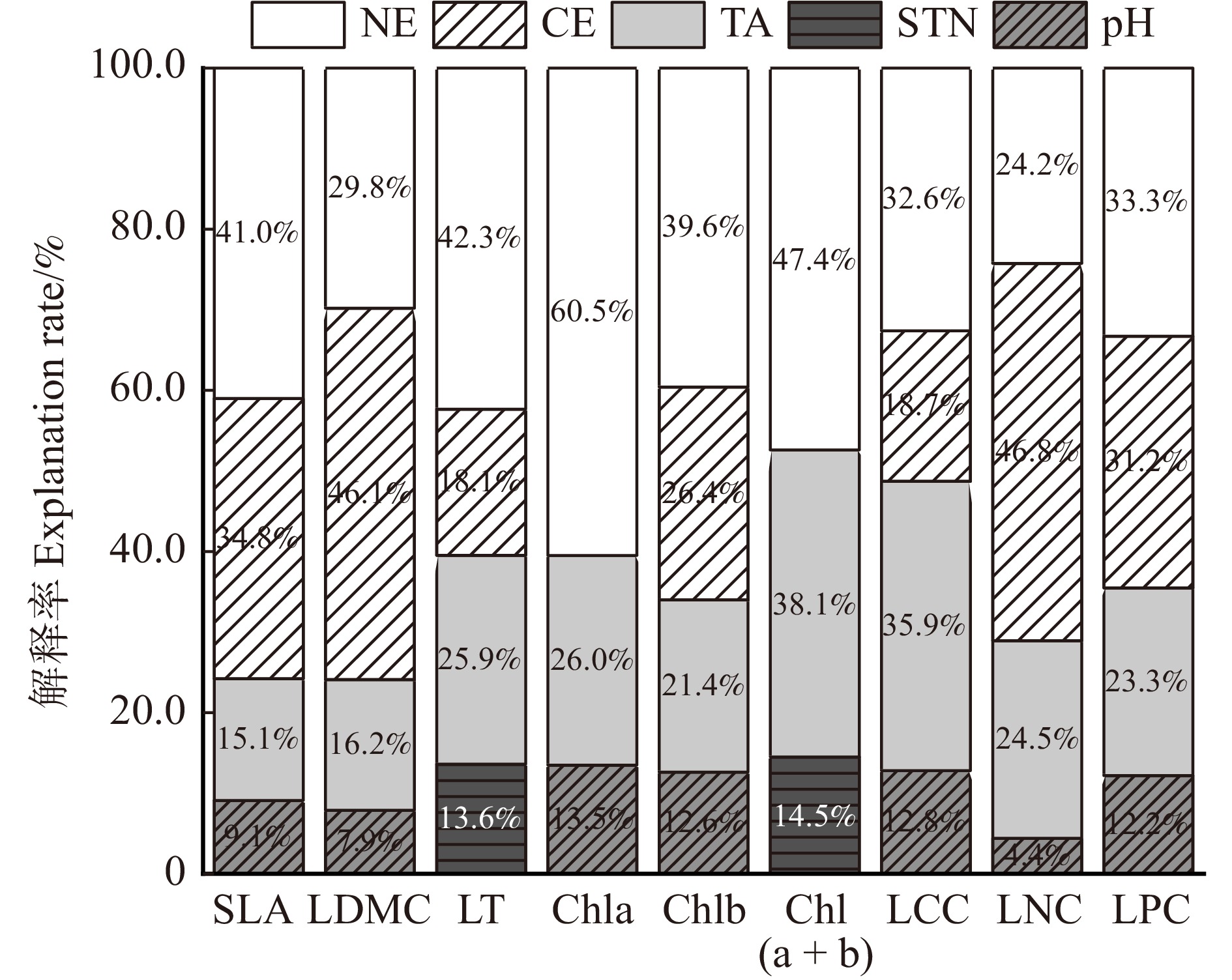Coordination and trade-off of leaf functional traits in Populus euphratica and their response to tree age and soil factors
-
摘要:目的
探究不同树龄胡杨叶功能性状的特征及其影响因素,揭示胡杨叶功能性状的种内变异及其适应特性,为胡杨的保护与管理提供理论依据。【方法】以不同树龄的胡杨为研究对象,通过相关性分析和方差分解等方法,研究胡杨叶片形态、光合生理、养分性状的变化特征以及对树龄和土壤因子的响应。
结果随着树龄的增加,叶干物质含量、叶绿素a含量、叶绿素b含量、叶绿素总量以及叶片碳、氮、磷含量呈增加趋势,而比叶面积、叶厚度呈减小趋势。各叶功能性状之间存在一定的相关性,其中叶绿素a含量、叶绿素b含量、叶绿素总量与叶片碳含量、叶氮含量、叶磷含量、叶干物质含量协同变化,与比叶面积和叶片厚度权衡变化,并且性状间的关系受树龄调控。比叶面积、叶干物质含量、叶绿素a含量、叶绿素b含量、叶碳含量、叶氮含量、叶磷含量主要受土壤pH和树龄的影响,叶片厚度、叶绿素总量主要受土壤氮含量和树龄的影响,表明树龄、土壤pH、土壤全氮含量是胡杨叶功能性状的主要影响因子,并且与土壤因子相比,树龄对叶功能性状变异的解释率更高,可以解释胡杨叶功能性状15.1% ~ 38.1%的变异。
结论随着树龄的增加,胡杨通过一定的性状变异和性状组合适应环境的变化,各叶功能性状的影响因子不同,其中树龄和土壤因子共同调控叶功能性状的变化,并且树龄在决定胡杨叶功能性状变异方面可能起着更为关键的作用。
Abstract:ObjectiveThis study aims to investigate the characteristics and influencing factors of leaf functional traits of Populus euphratica at different tree ages. Additionally, it aims to explore the intraspecific variation and adaptation characteristics of leaf functional tarits. The findings of this study aim to establish a theoretical basis for protection and management of P. euphratica.
MethodIn this study, P. euphratica trees of different tree ages were selected as research object, and the changes in leaf morphology, photosynthetic physiology, nutrient traits and their responses to tree age and soil factors were studied by means of correlation analysis and variance decomposition.
ResultWith the increase of tree age, leaf dry matter content, chlorophyll a content, chlorophyll b content, total chlorophyll content, leaf carbon content, leaf nitrogen content, and leaf phosphorus content increased, while specific leaf area and leaf thickness decreased. There was a certain correlation between the leaf functional traits, in which chlorophyll a content, chlorophyll b content and total chlorophyll content were significantly positively correlated with leaf dry matter content, leaf carbon content, leaf nitrogen content, and leaf phosphorus content, negatively correlated with specific leaf area and leaf thickness, and the relationship between traits was regulated by tree age. The specific leaf area, leaf dry matter content, chlorophyll a content, chlorophyll b content, leaf carbon content, leaf nitrogen content and leaf phosphorus content were mainly affected by tree age and soil pH, and leaf thickness and total chlorophyll content were mainly affected by tree age and soil total nitrogen content. It showed that tree age, soil pH and soil total nitrogen content were the main influencing factors of leaf functional traits, and compared with soil factors, tree age had a higher explanation rate for the variation of leaf functional traits, which could explain 15.1%−38.1% of the variation.
ConclusionWith the increase of tree age, P. euphratica adapts to environmental changes through certain trait variations and trait combinations, and the influencing factors of leaf functional traits are different. Among them, tree age and soil factors jointly regulate the change of leaf functional traits, and tree age may play a more critical role in determining the variation of leaf functional traits in P. euphratica.
-
Keywords:
- Populus euphratica /
- leaf functional trait /
- tree age /
- soil factor /
- coordination /
- trade-off
-
气候变化已经成为21世纪人类共同面临的重大环境问题,大气中CO2等温室气体浓度的增加,致使全球气候系统正在发生着有史以来从未有过的急剧变化,主要表现在全球变暖、降水格局变化、海平面上升等方面[1]。全球变暖的影响在北半球中高纬度的大陆内部表现的尤为明显[2]。森林作为陆地生态系统的重要组成部分,一直以来都是气候变化研究中的重点对象[3]。东北地区是我国纬度最高的区域,该区域内的森林对气候变化的响应受到全球气候变暖的影响,还具有明显的地域性特点[4]。众多研究表明,温度、降水对该地区的森林都有一定的影响[5-7],其中高温造成的负面影响尤为显著[8]。
长白落叶松(Larix olgensis)是北半球高纬度地区分布较为广泛的针叶树种之一,在海拔500~1 950 m均有分布并常形成大面积纯林。国外已有不少针对落叶松相关种属的生长与气候变化关系的研究在与我国临近的西伯利亚地区开展[9-12]。我国已有较多关于东北地区长白落叶松对气候变化响应的研究[13-15],但大多集中于长白山一带且多是针对高海拔或林线处林分[13, 16-17],在其他区域的研究还相对较少。吉林北部山区接近长白落叶松在我国的分布北界[18],在该区域开展研究对理解长白落叶松林对气候变化的响应有着重要的意义[19]。同时,该区域气候干暖化趋势明显,对树木生长已经产生了显著影响[20],急需开展相关研究为该地区森林的经营和保护提供理论依据。
树木生长对气候变化的响应受到树种、气候及林分因子等多方面的影响。如Brooks等[21]提出气候变化对不同树种的影响有差异,温度上升可能严重地影响某一树种的生长,却对另一树种影响不大。针对长白落叶松、兴安落叶松(L. gmelinii)进行的研究发现,不同海拔(温度、降水梯度)的落叶松对气候变化的响应存在明显差异[13, 22]。除树种、气候之外,还存在其他因素的影响。例如不同树龄的兴安落叶松的生长对气候变化的响应存在明显差异,老龄林更易受到水分胁迫的影响[23]。因此,气候条件、林分因子对森林与气候变化之间的响应关系都存在影响,但鲜有研究同时探究二者共同的影响及其各自的相对作用大小。
目前有关森林对气候变化响应的研究,多采用植被覆盖指数(Normalized difference vegetation index, NDVI)、碳收支、生产力等指标作为反映[5-6]。而用树木年轮(简称树轮)来研究生态系统对气候变化的响应,是全球气候变化研究的热点[24-26],相对其他方法,具有定年准确、连续性强、分辨率高等优点[27]。研究树木径向生长与气候因子的关系有助于理解一个地区森林生产力的生态限制因素,以及气候变化条件下森林生态系统的变化机理[8-9]。
本文以吉林北部山区不同林龄的长白落叶松天然林为研究对象,通过研究树木径向生长与历史气候变化的关系,探讨了气候条件、林分因子(林龄、林分密度、蓄积量、立地条件等)对年轮—气候关系的影响,以明确影响长白落叶松林对气候变化响应方式的主要影响因素。这对于在未来全球气候变暖的大背景下为该地区的长白落叶松林提供合理的保护抚育措施具有参考价值。
1. 研究区概况
研究区为吉林省北部山区,位于长白山北部余脉至老爷岭之间(42°49′48″~43°31′12″ N、128°00′36″~130°41′24″ E),沿纬度梯度自南向北包括敦化市的大蒲柴河林场(DPC)、汪清县的金苍林场(JC)和六道林场(LD)等3个研究地点,海拔550~800 m。研究区内为典型的温带季风气候,具有冬季冷且长、夏季热而短且四季分明的特点,年均气温1.0~3.0 ℃,最冷月均温-18 ℃,年降水量690~750 mm。该地区地带性植被为阔叶红松(Pinus koraiensis)林(分布于海拔500~1 100 m),也分布着各种次生森林类型,以及长白落叶松等人工林[28]。研究区内的长白落叶松林混生有少量白桦(Betula platyphylla)、春榆(Ulmus davidiana)、蒙古栎(Quercus mongolica)等阔叶树种,同时还伴生有少量欧亚大陆针叶林中的寒温性树种,如鱼鳞云杉(Picea jezonensis var. microsperma)、红皮云杉(Picea koraiensis)等。土壤以棕黑色的壤土或砂壤土为主。
2. 研究方法
2.1 树木年轮采样与年表建立
野外调查于2016年8—9月份进行,在上述3个研究地点分别设置5、4和8个20 m×50 m的长白落叶松样地(表 1)。对样地中所有胸径大于3 cm的乔木个体挂牌并进行每木检尺,测量树高、冠幅等。各样地的林龄采取国内外相关研究中常用的方法进行估测[29],使用生长锥钻取样地中胸径最大的5株乔木的完整年轮样品(至髓心),以这5个个体的平均年龄作为该样地的林龄,这样可以防止出现由于个别个体树龄较大而导致对林分年龄的估计偏高。另外,蓄积量采用相关蓄积量方程计算得到,立地条件则参考土壤表层含水率并结合实地调查确定,划分为好、中、差3个等级。
表 1 样地基本信息表Table 1. Basic information of each sample plot样地号
Sample plot纬度
Latitude经度
Longitude林龄
Stand age/a立地条件
Site
condition林分密度/(株·hm-2)
Stand density/
(tree·ha-1)蓄积量/(m3·hm-2)
Volume/
(m3·ha-1)平均树高
Mean tree
height/m平均胸径
Mean DBH/
cmDPC1 42°51′N 128°04′E 31 中Medium 1 150 238.56 17.97 16.93 DPC2 42°51′N 128°05′E 41 中Medium 1 580 379.56 21.55 16.19 DPC3 42°50′N 128°01′E 24 中Medium 1 140 204.71 18.69 15.35 DPC4 42°50′N 128°00′E 22 好Good 1 960 197.59 14.68 12.75 DPC5 42°52′N 128°01′E 37 中Medium 820 248.54 19.31 20.01 JC01 43°19′N 130°34′E 59 差Bad 340 182.71 20.26 26.39 JC02 43°19′N 130°34′E 53 差Bad 430 184.02 19.59 24.12 JC03 43°19′N 130°33′E 58 差Bad 1 820 160.30 12.16 12.20 JC04 43°22′N 130°35′E 56 中Medium 1 480 369.71 16.42 18.47 LD01 43°26′N 130°50′E 53 好Good 810 427.95 20.87 26.04 LD02 43°26′N 130°50′E 57 好Good 1 600 309.28 15.54 16.44 LD03 43°28′N 130°39′E 56 好Good 1 480 172.95 11.71 14.26 LD04 43°28′N 130°40′E 72 中Medium 1 500 231.66 12.32 15.63 LD05 43°31′N 130°41′E 29 中Medium 1 040 285.35 19.33 19.27 LD06 43°31′N 130°41′E 28 差Bad 990 223.46 17.48 18.06 LD07 43°31′N 130°41′E 28 好Good 1 090 223.97 16.98 17.71 LD08 43°31′N 130°41′E 28 差Bad 1 020 248.16 18.30 18.59 注: DPC代表大蒲柴河; JC代表金苍; LD代表六道。下同。Notes: DPC is for Dapuchaihe; JC is for Jincang; LD is for Liudao. The same below. 年轮采样选取了位于林冠层且健康无病害的长白落叶松30~40株,使用生长锥在胸径处(离地面1.3 m)沿东西、南北两个方向各取1个树轮样品。所采样品装入塑料吸管内保存。在实验室内按照标准处理程序进行固定、干燥并用砂纸打磨至年轮界限在显微镜下清晰可见。然后使用LINTAB 6树轮测量系统(Rinntech, Germany)以0.01 mm分辨率精确测量逐年轮宽序列。之后使用COFECHA程序[30]对同一样地中的所有年轮宽度序列进行相关性检验,剔除与主序列相关性差的序列,最后使用ARSTAN程序为剩余序列建立标准年表(表 2)[31]。基于此,得到了所有样地的轮宽指数(Ring width index, RWI)序列用于表征林分的逐年径向生长情况。由于各样地林龄不同,为了分析结果的可比较性,截取了所有样地的RWI序列共有的区间(1986—2015年)用于后续的数据分析。
表 2 样地标准年表统计参数Table 2. Summary statistics for standard chronology of each plot样地
Sample plot共同年区间
Common
interval time
span of year平均敏
感度
Mean
sensitivity标准差
Standard
deviationR1样本间平
均相关系数
Mean
correlations
among all
radiiR2不同树木
之间平均相关系数
Mean
correlations
between treesR3同一树木不同样
本之间平均相关系数
Mean correlations
between trees and
within trees信噪比
Signal-to-noise
ratio总体代表性
Express
population
signal第1特征
向量解释量
PCA1/%DPC1 1990—2016 0.203 0.218 0.447 0.655 0.422 21.195 0.955 0.408 DPC2 1984—2016 0.212 0.188 0.375 0.639 0.368 45.342 0.978 0.384 DPC3 1997—2016 0.215 0.185 0.512 0.550 0.506 21.607 0.956 0.449 DPC4 2000—2016 0.220 0.218 0.369 0.572 0.365 9.884 0.908 0.270 DPC5 1992—2016 0.248 0.260 0.449 0.651 0.446 27.539 0.965 0.388 JC01 1969—2016 0.178 0.203 0.180 0.573 0.172 7.155 0.877 0.511 JC02 1974—2016 0.181 0.208 0.444 0.599 0.440 15.976 0.941 0.487 JC03 1969—2016 0.183 0.184 0.367 0.611 0.363 26.076 0.963 0.548 JC04 1979—2016 0.190 0.199 0.505 0.760 0.501 12.733 0.927 0.288 LD01 1979—2016 0.103 0.157 0.217 0.505 0.213 27.837 0.965 0.395 LD02 1966—2016 0.135 0.281 0.501 0.721 0.494 13.516 0.931 0.429 LD03 1968—2016 0.136 0.161 0.298 0.459 0.295 16.985 0.944 0.419 LD04 1961—2016 0.150 0.159 0.340 0.618 0.337 6.475 0.866 0.527 LD05 1994—2016 0.155 0.149 0.326 0.512 0.322 43.199 0.977 0.491 LD06 1993—2016 0.156 0.201 0.351 0.594 0.343 52.478 0.981 0.520 LD07 1993—2016 0.162 0.328 0.443 0.524 0.435 55.652 0.982 0.531 LD08 1993—2016 0.169 0.166 0.493 0.696 0.490 56.135 0.982 0.528 2.2 历史气候数据
本研究使用了2个来源的气候数据。用于分析树木径向生长与历史气候之间关系所使用的数据来自于东安格利亚大学的CRU TS 3.22高分辨率气候数据集,我们从中提取了1986—2015年间的月均温及帕尔默干旱指数(Palmer drought severity index, PDSI)。其中PDSI是一个基于降水量和温度的反映干燥程度的指标,能够很好反映水分的盈缺。为使分析结果更清晰,按照季节对一年的12个月进行了划分,其中上年12月至当年2月为冬季,3—5月为春季,6—8月为夏季,9—11月为秋季,并将对应月份的温度、PDSI取平均作为季节气候数据。CRU数据的空间分辨率为0.5°(研究区所在纬度,栅格边长约为41 km),由于金苍和六道两个研究地点的距离较近,位于同一栅格内,因此在分析时两地使用的气候数据相同。考虑到树木当年的生长与上年的气候之间存在“滞后效应”[32],因此在数据分析时除了使用当年春季到秋季的气候数据,还使用了上年四季的气候数据。
但上述CRU的气候数据无法反映出不同样地间的气候条件差异。采用Wang等[33]利用国家气象台站数据建立的模型,基于样地经、纬度和海拔估算了各样地的年均温(Annual mean temperature, AMT)、年均降水量(Annual precipitation, AP)。然后使用估算的年均温、降水计算了各样地的潜在蒸散量(Potential evapotranspiration, PET)[33]。研究表明,能量和水分的有效性是影响生产力的关键气候要素[34],这里采用PET和PDSI分别反映能量和水分的有效性。由于无法获取计算PDSI需要的一些数据,因此采用从CRU数据集中提取的PDSI数据(取1986—2015年间PDSI的均值)。
2.3 数据分析
首先分析了研究区近30年的年均温、PDSI的变化趋势,然后对各样地的RWI序列与对应的各季节(上年春季到当年秋季)的平均温度、PDSI序列进行相关性分析。由于季节气候指标较多,因此RWI与季节气候指标的相关系数只能用以初步判断影响年轮—气候关系的因素。为能明确起主要作用的因素,对上述得到的相关系数矩阵进行主成分分析。为研究气候条件和林分因子的相对影响大小,计算了各样地的气候及林分因子对PCA前2轴得分的解释力(R2),同时建立多元线性模型并使用逐步回归筛选得到对年轮—气候关系影响最显著的变量。主成分分析和逐步回归分析均用R软件完成。
3. 结果和分析
3.1 研究区气候的干暖化趋势
本研究中不同地点在空间上有一定距离,也表现在气候上的差异(图 1)。大蒲柴河(DPC)温度较金苍(JC)和六道(LD)林场低,PDSI则较金苍和六道低。即相对金苍和六道,大蒲柴河的气候条件更为干冷,但近30年(1986—2015年)的年气候指标变化仍表现出相似的趋势。两地均以0.014 ℃/a的速率变暖,PDSI也以近似速率下降。结合上述分析的温度和PDSI数据变化趋势,不难发现研究区在近30年呈现明显的干暖化趋势。
3.2 落叶松径向生长与气候变化的关系
建立标准年表,其统计参数如表 2所示,年表的平均敏感度介于0.103~0.248之间,标准差则介于0.149~0.281之间,样本总体代表性高达0.866~0.982,均超过了样本总体代表性(EPS)的阈值0.85[35]。这完全符合吴祥定[27]对于高质量年表的要求,适合进一步用以年轮与气候变化关系的分析。
对标准年表轮宽指数与季节温度、PDSI进行的相关分析表明,落叶松径向生长明显受到气候变化的影响,与上年和当年多个季节的温度和PDSI都有显著的相关性。更为重要的是,不同林龄的林分对气候变化的响应存在明显差异(图 2),温度升高对林龄小的林分有促进生长的作用,而对林龄过大的林分则会产生抑制作用,且林龄越大抑制作用越明显。
在对年轮—气候关系进行主成分分析后,发现PCA 1轴和2轴共解释了63.1%的变异,表明PCA前2轴能较好地反映年轮—气候关系中的主要信息,因此可用于进一步探讨不同样地的气候条件、林分因子等因素的影响。由PCA前2轴载荷系数(表 3)中可以看出,PCA 1的季节PDSI的载荷系数均为负数,且绝对值明显高于温度指标,这说明PCA 1主要反映径向生长对水分历史变化的响应,径向生长受到水分的限制作用,PCA 1得分为负时值越小,受到水分限制作用越显著。而PCA 2的季节温度的载荷系数也多为负数且绝对值明显高于PDSI,主要反映轮宽与温度指标的历史变化的相关性,PCA 2得分的负值越小表示受温度的限制作用越强。
表 3 PCA第1、2轴载荷Table 3. Loading of seasonal climatic factors on PCA 1 and PCA 2季节气候指标
Seasonal climatic factorPCA 1 PCA 2 P_Spr_T — 0.369 P_Aut_T 0.287 -0.358 P_Win_T — -0.472 C_Spr_T 0.272 0.216 C_Sum_T 0.275 — C_Aut _T -0.161 -0.326 P_Aut_T — -0.375 P_Spr_PDSI -0.165 -0.331 P_Sum_PDSI -0.364 — P_Aut_PDSI -0.356 — P_Win_PDSI -0.229 0.241 C_Spr_PDSI -0.382 -0.106 C_Sum_PDSI -0.381 — C_Aut_PDSI -0.305 0.152 注:P表示上年; C表示当年。Spr、Sum、Aut、Win分别表示春、夏、秋、冬季。下同。“—”表示系数绝对值过小。Notes: P means last year; C means current year. Spr, Sum, Aut, Win represent spring, summer, autumn, winter, respectively. The same below. “—” means absolute value of coefficients is too small. 3.3 气候条件、林分因子对年轮—气候关系的影响
从PCA分析结果(图 3)可以看到,由于气候条件的差异,能够区分出各个地点所对应的样地,DPC的样地居于图右侧,而LD的样地则位于左侧,JC的样地多数处于二者之间。结合各个样地的PET数据,PCA 1轴上越往右,对应样地的PET越大,PDSI的箭头也均朝向左边。这表明PCA1轴反映了样地气候条件差异对年轮—气候关系的影响(表 3)。通过计算样地气候条件、林分因子等对PCA轴的单因素解释力(表 4),发现PET和PDSI都与PCA 1得分显著相关,且两者作用方向相反,而林龄、林分密度等林分因子与PCA 1、PCA 2得分的相关性均不显著。
表 4 样地气候条件及林分因子对PCA前两轴得分的解释力(R2)Table 4. Explanatory power of climatic factors and stand conditions for the scores of PCA 1 and 2 axis (R2)变量Variable PCA 1 PCA 2 PDSI Palmer drought severity index -0.503** -0.006 潜在蒸发量Potential evapotranspiration 0.301* -0.024 林龄Stand age -0.065 0.163 林分密度Stand density 0.008 0.004 蓄积量Volume 0.014 0.164 立地条件Stand factor 0.105 0.167 注:*相关性较显著(P<0.05),**表示相关性显著(P<0.01),***表示相关性极显著(P<0.01)。下同。Notes: - means negative correlation. * represents significant correlation at P<0.05 level, ** represents significant correlation at P<0.01 level, *** represents significant correlation at P<0.001 level. The same below. 通过逐步回归筛选相关气候因子和林分因子后的结果(表 5),可以看到PDSI对PCA 1的解释力为50.27%,说明样地的水分条件对年轮—气候关系有重要作用; 对于PCA 2,林龄也显著解释了25.58%的变异,说明林龄也显著影响了径向生长对历史气候变化的响应,进一步支持了图 2的结果。综上结果表明,年轮—气候关系主要受到样地气候条件的影响,其次受到林龄的影响,而蓄积量、林分密度等其余林分因子的影响则相对较弱。
表 5 气候指标及林分条件对PCA前两轴得分的逐步回归分析方差分析Table 5. Stepwise regression analysis of the scores of PCA 1 and PCA 2 with climatic factors and stand conditions项目Item df SS/% Sum Sq Mean Sq F Pr(>F) PCA 1 PDSI Palmerdrought severity index 1 50.27 52.63 52.63 15.57 0.00*** 潜在蒸发量Potential evapotranspiration 1 5.36 5.61 5.61 1.87 0.19 林分密度Stand density 1 7.18 7.51 7.51 2.51 0.14 残差Residuals 13 37.19 38.94 3.00 PCA 2 PDSI Palmerdrought severity index 1 0.56 0.25 0.25 0.12 0.74 林龄Stand age 1 26.48 12.07 12.07 5.67 0.03* 蓄积量Volume 1 12.22 5.57 5.57 2.61 0.13 残差Residual 13 60.74 27.70 2.13 4. 讨论
本研究对处于不同气候和林分条件下的长白落叶松林的年轮—气候关系进行了分析,得到的结果与以往的相关研究存在一些异同。
4.1 气候条件对年轮—气候关系的影响
此前已有长白落叶松的相关研究表明,其径向生长对气候变化的响应与气候密切相关。如于大炮等[13]在长白山北坡的研究发现长白落叶松的年表—气候关系随海拔不同而有显著差异,并与林线位置有关。一般认为,长白落叶松的生长在高海拔主要受气温影响,在低海拔则主要受降水量影响[16, 36]。对兴安落叶松等其他树种的研究,也广泛发现了这种现象,这与低海拔温度较高、蒸散较强,导致的水分有效性较低有关[22, 37]。在本研究中,大 蒲柴河、六道和金苍经纬度差异并不是很大,但PDSI仍然解释了PCA 1高达50.27%的变异(表 5),这充分反映了气候条件确实对年轮—气候关系存在重要影响。本研究中所有样地海拔均不太高(550~800 m),结果表明,PDSI的作用远高于PET,即中低海拔长白山落叶松的年表—气候关系确实主要受水分条件的影响,与上述研究一致。不过,这并不能说明热量不起作用。在表 5中,如果将PET放在PDSI之前进入模型,则PET可显著解释PCA 1的30.05%的变异(表 6)。事实上,所谓气候干暖化常常是由于气候变暖导致的蒸散增加、有效水分减少引起的,未必一定是由于降水量的下降导致[38]。这一点在PCA排序图中也很明显,图 3中各个样地的温度朝PCA 1的右方增大,而PDSI箭头方向则刚好相反,说明PCA 1右侧样地的PDSI较低是由于其较高的温度(蒸散)所导致。综上,本研究中不同地点长白落叶松对历史气候变化响应的差异主要受水分条件的影响,但水分亏缺则随着热量的上升而加剧。这也意味着,随着东北地区今后进一步的气候变暖,长白落叶松(尤其是老龄林)的生长将会受到严重威胁。
表 6 变量顺序不同的方差分析Table 6. Appendix 1 variance analysis of variables in different order项目Item df SS/% Sum Sq Mean Sq F Pr(>F) PCA 1 潜在蒸发量Potential evapotranspiration 1 30.05 31.46 31.46 10.50 0.01* PDSI Palmer drought severity index 1 25.58 26.78 26.78 8.94 0.01* 林分密度Stand density 1 7.18 7.51 7.51 2.51 0.14 残差Residual 13 37.19 38.94 3.00 PCA 2 PDSI Palmer drought severity index 1 0.56 0.25 0.25 0.12 0.74 蓄积量Volume 1 16.34 7.45 7.45 3.50 0.08 林龄Stand density 1 22.36 10.19 10.19 4.78 0.05 残差Residual 13 60.74 27.70 2.13 4.2 林分因子对年轮—气候关系的影响
研究表明,过去30年的气候变暖对不同林龄落叶松的影响有着很大差异(图 2):林龄较小的落叶松,RWI与各季节历史温度变化多呈正相关,说明气候变暖能够促进其生长; 而林龄较大的落叶松则多呈负相关关系,说明气候变暖对其径向生长有明显的负效应。
年轮与历史气候变化的关系除了受气候条件影响之外,还受到林分条件的影响。具体来说,树木径向生长也受竞争以及林分株数密度、树种、林龄等因素的影响[23, 39]。而在本研究中,单从表 3的单因素解释力的结果来看,这些林分因子似乎没有影响。而多元回归模型的结果却表明,在同时考虑其他气候、林分因子时,林龄对年轮—气候关系存在显著影响(表 5)。
一些研究表明,水分对径向生长的限制作用会随林龄增加而加剧,一般认为大树对气候的变化更加敏感[40]。但是,关于林龄的影响机制还存在争议。一方面,随着林龄的增加林分生产力下降是常见的现象,可能说明随着林龄增大、树木活力下降,因此对环境胁迫更加敏感。但随着林龄的增长,还伴随着树木大小(蓄积量)的增加,大树由于蒸腾作用强、对水分和养分的需求大,也可导致其对气候变化更敏感[41]。本研究结果表明,林龄对PCA2轴的解释力最大,解释了26.48%的变异,这和上述研究一致,说明林龄是影响年轮—气候关系的重要因素。表 5中,蓄积量的解释力不显著。但即使是将蓄积量放在林龄之前进入模型(表 6),其解释力在0.05水平上也不显著。因此,本研究结果更多地支持上述前一种解释,即林龄自身对长白落叶松的气候变化响应有着重要作用,而树木大小的作用相对是较弱的。不过,本文的结果与Martínez-Vilalta[41]的结果相反,因此,关于林龄和树木大小的影响,还有待于今后进一步研究才能确定。
还有研究表明,林分密度是影响年轮—气候关系的一个重要因素[42]。而在本研究中,林分密度的解释力较弱且不显著(表 5)。本文中林分密度在340~1 960株/hm2之间,样地间差异足够大,因此可以排除是由于林分密度的梯度不够大导致其解释力不显著。即林分密度对年轮—气候关系的影响相对较弱,这一结果也与以往一些研究不同。因此,林分密度对径向生长的气候变化响应究竟有多大影响,也有待进一步探讨。
4.3 干暖化对长白落叶松林的潜在影响
图 1表明吉林北部山区的确存在明显的干暖化趋势,与以往东北地区研究一致。气候干暖化对东北树木生长的不利影响也得到众多研究证实。比如,对大兴安岭库都尔地区兴安落叶松的研究表明,区域性的干暖化趋势已经影响到当地主要树木的生长[14]。对阔叶红松林的研究也表明,虽然近几十年的气候干暖化对其不同演替阶段的径向生长影响复杂,正负效应都存在,但已经导致红松林生长的明显下降[19]。随着今后干暖化趋势的加剧,可以预料到蒸发、蒸腾作用的加剧从而导致土壤水分有效性的降低。这一威胁对于林龄较大的林分尤为严重,可能导致其严重的生长衰退甚至死亡[38],而成熟林却是天然林保护的重要对象。因此,需要深入研究如何采取适当的措施以减少干暖化的不利影响,以有效保护东北地区的森林生态系统。
-
表 1 不同树龄胡杨人工林基本特征
Table 1 Basic characteristics of Poplus euphratica at different tree ages
树龄/a
Tree age/year平均胸径
Mean DBH/cm平均树高
Mean tree height/m1 0.33 0.34 2 1.52 0.73 3 2.05 1.33 6 3.01 2.63 9 7.81 7.94 12 12.73 11.79 表 2 叶形态、养分、光合生理性状间的相关性系数
Table 2 Correlation coefficients among leaf morphology, nutrient, photosynthetic physiological traits
性状
TraitSLA LDMC LT Chla Chlb Chl(a + b) LCC LNC LDMC −0.837** LT 0.627** −0.796** Chla −0.334** 0.353** −0.246* Chlb −0.282** 0.325** −0.246* 0.909** Chl(a + b) −0.322** 0.350** −0.251* 0.988** 0.963** LCC −0.568** 0.576** −0.446** 0.263* 0.213* 0.232* LNC −0.619** 0.818** −0.659** 0.302** 0.268** 0.296** 0.494** LPC −0.541* 0.661** −0.520** 0.332** 0.239** 0.304** 0.490** 0.565** 注:SLA. 比叶面积;LDMC. 叶干物质含量;LT. 叶片厚度;Chla. 叶绿素a含量;Chlb. 叶绿素b含量;Chl(a + b). 叶绿素总量;LCC. 叶碳含量;LNC. 叶氮含量;LPC. 叶磷含量。*表示在0.05水平上显著相关,**表示在0.01水平上极显著相关。下同。Notes: SLA, specific leaf area; LDMC, leaf dry matter content ; LT, leaf thickness; Chla, chlorophyll a content; Chlb, chlorophyll b content; Chl(a + b), total chlorophyll content; LCC, leaf carbon content; LNC, leaf nitrogen content; LPC, leaf phosphorus content. * means significant correlation at 0.05 level, ** means extremely significant correlation at 0.01 level. Same as below. 表 3 叶片功能性状初始因子载荷矩阵和主成分贡献率
Table 3 Factor matrix and principal component contribution rate of leaf functional traits
指标
Index主成分
Principal component (PC)PC1 PC2 SLA −0.361 0.209 LDMC 0.402 −0.241 LT −0.338 0.246 Chla 0.311 0.479 Chlb 0.293 0.495 Chl(a + b) 0.311 0.495 LCC 0.292 −0.198 LNC 0.354 −0.225 LPC 0.323 −0.170 特征值 Eigenvalue 4.863 2.153 贡献率 Contribution rate/% 54.0 23.9 累计贡献率 Cumulative contribution rate/% 54.0 77.9 表 4 叶片功能性状与土壤因子、树龄的相关性系数
Table 4 Correlation coefficients of leaf functional traits with soil factors and tree age
性状 Trait SOC STN STP pH SEC TA SLA −0.669** −0.784** −0.741** 0.687** −0.531* −0.659** LDMC 0.812** 0.891** 0.814** −0.753** 0.687** 0.903** LT −0.578* −0.719** −0.697** 0.617** −0.467* −0.534* Chla 0.623** 0.616** 0.599** −0.474* 0.499 0.709** Chlb 0.628** 0.651** 0.677** −0.532* 0.387 0.713** Chl(a + b) 0.629** 0.633** 0.630** −0.497* 0.479 0.715** LCC 0.702** 0.708** 0.542* −0.457* 0.619** 0.757** LNC 0.884** 0.848** 0.713** −0.736** 0.644** 0.854** LPC 0.759** 0.801** 0.680** −0.684** 0.818** 0.816** 注:SOC. 有机碳含量;STN. 土壤全氮含量;STP. 土壤全磷含量;pH. 土壤pH ;SEC. 土壤电导率;TA. 树龄。下同。Notes: SOC, soil organic carbon; STN, soil total nitrogen; STP, soil total phosphorus; pH, soil pH; SEC, soil electric conductivity; TA, tree age. The same below. -
[1] 戚德辉, 温仲明, 杨士梭, 等. 基于功能性状的铁杆蒿对环境变化的响应与适应[J]. 应用生态学报, 2015, 26(7): 1921−1927. Qi D H, Wen Z M, Yang S S, et al. Trait-based responses and adaptation of Artemisia sacrorum to environmental changes[J]. Chinese Journal of Applied Ecology, 2015, 26(7): 1921−1927.
[2] Rozendaal D M A, Hurtdo V H, Poorter L. Plasticity in leaf traits of 38 tropical tree species in response to light: relationships with light demand and adult stature[J]. Functional Ecology, 2006, 20(2): 207−216. doi: 10.1111/j.1365-2435.2006.01105.x
[3] 孙梅, 田昆, 张贇, 等. 植物叶片功能性状及其环境适应研究[J]. 植物科学学报, 2017, 35(6): 940−949. Sun M, Tian K, Zhang Y, et al. Research on leaf functional traits and their environmental adaptation[J]. Plant Science Journal, 2017, 35(6): 940−949.
[4] 庞世龙, 欧芷阳, 申文辉, 等. 桂西南喀斯特地区优势木本经济植物叶功能性状变异及其适应策略[J]. 广西植物, 2021, 41(5): 707−714. Pang S L, Ou Z Y, Shen W H, et al. Leaf function traits variations and adaptive strategies of dominant woody economic plants in karst area of Southwest Guangxi[J]. Guihaia, 2021, 41(5): 707−714.
[5] Fajardo A, Siefert A. Intraspecific trait variation and the leaf economics spectrum across resource gradients and levels of organization[J]. Ecology, 2018, 99(5): 1024−1030. doi: 10.1002/ecy.2194
[6] Sun L, Wang H F, Cai Y, et al. Disentangling the interspecific and intraspecific variation in functional traits of desert plant communities under different moisture gradients[J]. Forests, 2022, 13(7): 1088. doi: 10.3390/f13071088
[7] 段媛媛, 宋丽娟, 牛素旗, 等. 不同林龄刺槐叶功能性状差异及其与土壤养分的关系[J]. 应用生态学报, 2017, 28(1): 28−36. Duan Y Y, Song L J, Niu S Q, et al. Variation in leaf functional traits of different-aged Robinia pseudoacacia and relationships with soil nutrients[J]. Chinese Journal of Applied Ecology, 2017, 28(1): 28−36.
[8] Wright I J, Reich P B, Westoby M, et al. The world-wide leaf economics spectrum[J]. Nature, 2004, 428: 821−827. doi: 10.1038/nature02403
[9] 王雪梅, 闫帮国, 史亮涛, 等. 车桑子幼苗生物量分配与叶性状对氮磷浓度的响应差异[J]. 植物生态学报, 2020, 44(12): 1247−1261. doi: 10.17521/cjpe.2020.0199 Wang X M, Yan B G, Shi L T, et al. Different responses of biomass allocation and leaf traits of Dodonaea viscosa to concentrations of nitrogen and phosphorus[J]. Chinese Journal of Plant Ecology, 2020, 44(12): 1247−1261. doi: 10.17521/cjpe.2020.0199
[10] 刘思文, 艾也博, 刘艳红. 北京松山油松叶功能性状沿海拔梯度的变化及其环境解释[J]. 北京林业大学学报, 2021, 43(4): 47−55. Liu S W, Ai Y B, Liu Y H. Variations in leaf functional traits along the altitude gradient of Pinus tabuliformis and its environmental explanations in Beijing Songshan Mountain[J]. Journal of Beijing Forestry University, 2021, 43(4): 47−55.
[11] Wang Z H, Townsend P A, Kruger E L. Leaf spectroscopy reveals divergent inter-and intra-species foliar trait covariation and trait-environment relationships across NEON domains[J]. New Phytologist, 2022, 235: 923−938. doi: 10.1111/nph.18204
[12] Liu Z L, Jiang F, Li F R, et al. Coordination of intra and inter-species leaf traits according to leaf phenology and plant age for three temperate broadleaf species with different shade tolerances[J]. Forest Ecology and Management, 2019, 434: 63−75. doi: 10.1016/j.foreco.2018.12.008
[13] Valladares F, Niinemets U. Shade tolerance, a key plant feature of complex nature and consequences[J]. Annual Review of Ecology, Evolution and Systematics, 2008, 39: 237–257.
[14] Martin A R, Thomas S C. Size-dependent changes in leaf and wood chemical traits in two Caribbean rainforest trees[J]. Tree Physiology, 2014, 33(12): 1338−1353.
[15] Liu F D, Yang W J, Wang Z S, et al. Plant size effects on the relationships among specific leaf area, leaf nutrient content, and photosynthetic capacity in tropical woody species[J]. Acta Oecologica-International Journal of Ecology, 2010, 36(2): 149−159. doi: 10.1016/j.actao.2009.11.004
[16] Keyimu M, Halik Ü, Betz F, et al. Vitality variation and population structure of a riparian in the lower reaches of the Tarim River, NW China[J]. Journal of Forestry Research, 2018, 29: 749−760. doi: 10.1007/s11676-017-0478-4
[17] 王晶, 殷飞, 林宁. 叶尔羌河流域荒漠河岸林胡杨叶片和凋落叶的生态化学计量特征[J]. 植物资源与环境学报, 2021, 30(5): 42−49. doi: 10.3969/j.issn.1674-7895.2021.05.05 Wang J, Yin F, Lin N. Ecological stoichiometric characteristics of leaf of Populus euphratica from desert riparian forest in Yarkant River Basin[J]. Journal of Plant Resources and Environment, 2021, 30(5): 42−49. doi: 10.3969/j.issn.1674-7895.2021.05.05
[18] 王希义, 徐海量, 潘存德, 等. 塔里木河下游珍稀濒危植物胡杨的种群生存特征研究[J]. 西北植物学报, 2017, 37(11): 2282−2289. doi: 10.7606/j.issn.1000-4025.2017.11.2282 Wang X Y, Xu H L, Pan C D, et al. Population survival characteristics of Populus euphratica which is rare and endangered in the lower reaches of Tarim River[J]. Acta Botanica Sinica of Northwest China, 2017, 37(11): 2282−2289. doi: 10.7606/j.issn.1000-4025.2017.11.2282
[19] 张肖, 吕瑞恒, 梁继业, 等. 胡杨生殖构件空间分布特征及其养分动态分析[J]. 干旱区研究, 2017, 34(1): 95−103. Zhang X, Lü R H, Liang J Y, et al. Spatial distribution of reproductive shoots and dynamic change of nutrient contents of Populus euphratica[J]. Arid Zone Research, 2017, 34(1): 95−103.
[20] 李端, 司建华, 张小由, 等. 胡杨(Populus euphratica)对干旱胁迫的生态适应[J]. 中国沙漠, 2020, 40(2): 17−23. Li D, Si J H, Zhang X Y, et al. Ecological adaptation of Populus euphratica to drought stress[J]. Journal of Desert Research, 2020, 40(2): 17−23.
[21] 热孜也木·阿布力孜, 玉米提·哈力克, 塔依尔江·艾山, 等. 塔里木河下游胡杨叶片性状特征及其对水分胁迫的响应[J]. 东北林业大学学报, 2019, 47(5): 46−51. doi: 10.3969/j.issn.1000-5382.2019.05.010 Reziya Abulizi, Umut Halik, Tayierjiang Aishan, et al. Leaf characteristics of Populus euphratica and its response to water stress in the lower reaches of Tarim River[J]. Journal of Northeast Forestry University, 2019, 47(5): 46−51. doi: 10.3969/j.issn.1000-5382.2019.05.010
[22] 温云梦. 不同地下水埋深下胡杨叶片色素及光谱变化特征分析[D]. 阿拉尔: 塔里木大学, 2022. Wen Y M. Characterization of pigment and spectral changes of poplar leaves under different groundwater depths of groundwater burial[D]. Aral: Tarim University, 2022.
[23] Wang L L, Zhao G X, Li M, et al. C∶N∶P stoichiometry and leaf traits of halophytes in an arid saline environment, Northwest China[J]. PLoS One, 2015, 10(3): 1−16.
[24] Zhang X L, Zhou J H, Guan T Y, et al. Spatial variation in leaf nutrient of dominant desert riparian plant species in an arid inland river basin of China[J]. Ecology and Evolution, 2019, 9(3): 1523−1531. doi: 10.1002/ece3.4877
[25] 曹生奎, 冯起, 司建华, 等. 荒漠河岸林胡杨养分状况研究[J]. 中国沙漠, 2011, 31(5): 1131−1140. Cao S K, Feng Q, Si J H, et al. Status of foliar nutrients in Populus euphratica desert riparian forest in northwestern China[J]. Journal of Desert Research, 2011, 31(5): 1131−1140.
[26] 王文娟, 吕慧, 钟悦鸣, 等. 胡杨异形叶性状与其个体发育的关系[J]. 北京林业大学学报, 2019, 41(2): 62−69. Wang W J, Lü H, Zhong Y M, et al. Relationship between heteromorphic leaf traits of Populus euphratica and its individual development[J]. Journal of Beijing Forestry University, 2019, 41(2): 62−69.
[27] 单凌飞, 丁颖慧, 王双蕾, 等. 胡杨不同发育阶段叶片光合作用及其光响应特征[J]. 生态科学, 2019, 38(6): 22−29. Shan L F, Ding Y H, Wang S L, et al. Leaf photosynthesis and light response characteristics of Populus euphratica in different developmental stages[J]. Ecological Science, 2019, 38(6): 22−29.
[28] 庞志强, 卢炜丽, 姜丽莎, 等. 滇中喀斯特41种不同生长型植物叶性状研究[J]. 广西植物, 2019, 39(8): 1126−1138. Pang Z Q, Lu W L, Jiang L S, et al. Leaf traits of different growing plants in karst area of Shilin, China[J]. Guihaia, 2019, 39(8): 1126−1138.
[29] Kenozo T, Inoue Y, Yoshimura M, et al. Height-realted changes in leaf photosynthetic in diverse Bornean tropical rain forest trees[J]. Oecologia, 2015, 177: 191−202. doi: 10.1007/s00442-014-3126-0
[30] Liao L C, Jiang H, Long W X, et al. Leaf functional traits are related to tree size and location in cotton trees Bombax malabaricum[J]. Tropical Conservation Science, 2020, 13: 1−9.
[31] Shao Q S, Wang H Z, Guo H P, et al. Effects of shade treatments on photosynthetic characteristics, chloroplast ultrastructure, and physiology of Anoectochilus roxburghii[J]. PLoS One, 2014, 9(2): e85996. doi: 10.1371/journal.pone.0085996
[32] 翟占伟, 龚吉蕊, 罗亲普, 等. 氮添加对内蒙古温带草原羊草光合特性的影响[J]. 植物生态学报, 2017, 41(2): 196−208. doi: 10.17521/cjpe.2016.0128 Zhai Z W, Gong J R, Luo Q P, et al. Effects of nitrogen addition on photosynthetic characteristics of Leymus chinensis in temperate grassland of Nei Mongol, China[J]. Chinese Journal of Plant Ecology, 2017, 41(2): 196−208. doi: 10.17521/cjpe.2016.0128
[33] 冯秋红, 史作民, 董莉莉, 等. 南北样带温带区栎属树种功能性状间的关系及其对气象因子的响应[J]. 植物生态学报, 2010, 34(6): 619−627. doi: 10.3773/j.issn.1005-264x.2010.06.001 Feng Q H, Shi Z M, Dong L L, et al. Relationships among functional traits of Quercus species and their response to meteorological factors in temperate zone of North-South transect of eastern China[J]. Chinese Journal of Plant Ecology, 2010, 34(6): 619−627. doi: 10.3773/j.issn.1005-264x.2010.06.001
[34] 何斌, 李青, 冯图, 等. 不同林龄马尾松人工林针叶功能性状及其与土壤养分的关系[J]. 南京林业大学学报(自然科学版), 2020, 44(2): 181−190. He B, Li Q, Feng T, et al. Variation in leaf functional traits of different-aged Pinus massoniana communities and relationships with soil nutrients[J]. Journal of Nanjing Forestry University (Natural Science Edition), 2020, 44(2): 181−190.
[35] 石义强, 热孜也木·阿布力孜, 玉米提·哈力克, 等. 胡杨叶功能性状差异及其与树形因子的关系[J]. 森林与环境学报, 2023, 43(1): 1−7. Shi Y Q, Reziya Abulizi, Umut Halik, et al. Diffenences in leaf functional traits of Populus euphratica at different growth stages and its relationship with tree shape factors[J]. Journal of Forest and Environment, 2023, 43(1): 1−7.
[36] 李耀琪, 王志恒. 植物叶片形态的生态功能、地理分布与成因[J]. 植物生态学报, 2021, 45(10): 1154−1172. doi: 10.17521/cjpe.2020.0405 Li Y Q, Wang Z H. Leaf morphological traits: ecological function, geographic distribution and gdrivers[J]. Chinese Journal of Plant Ecology, 2021, 45(10): 1154−1172. doi: 10.17521/cjpe.2020.0405
[37] 周丽丽, 钱瑞玲, 李树斌, 等. 滨海沙地主要造林树种叶片功能性状及养分重吸收特征[J]. 应用生态学报, 2019, 30(7): 2320−2328. Zhou L L, Qian R L, Li S B, et al. Leaf functional traits and nutrient resorption among major silviculture tree species in coastal sandy site[J]. Chinese Journal of Applied Ecology, 2019, 30(7): 2320−2328.
[38] 胡耀升, 么旭阳, 刘艳红. 长白山不同演替阶段森林植物功能性状及其与地形因子间的关系[J]. 生态学报, 2014, 34(20): 5915−5924. Hu Y S, Yao X Y, Liu Y H. The functional traits of forests at different succession stages and their relationship to terrain factors in Changbai Mountains[J]. Acta Ecologica Sinica, 2014, 34(20): 5915−5924.
[39] 王敬哲, 陈志强, 陈志彪, 等. 南方红壤侵蚀区不同植被恢复年限下芒萁叶功能性状对土壤因子的响应[J]. 生态学报, 2020, 40(3): 900−909. Wang J Z, Chen Z Q, Chen Z B, et al. Response of functional traits of Dicranopteris dichotoma leaves to soil factors in different vegetation restoration years in red soil erosion area of southern China[J]. Acta Ecologica Sinica, 2020, 40(3): 900−909.
[40] Lusk C H, Reich P B, Montgomery R A, et al. Why are evergreen leaves so contray about shade?[J]. Trends in Ecology & Evolution, 2008, 23(6): 299−303.
[41] Poorter H, Niinemets U, Poorter L, et al. Causes and consequences of variation in leaf mass per area (LMA): a meta-analysis[J]. New Phytologist, 2009, 182(3): 565−588. doi: 10.1111/j.1469-8137.2009.02830.x
[42] 苏文华, 施展, 杨波, 等. 滇石栎沿纬度梯度叶片功能性状的种内变化[J]. 植物分类与资源学报, 2015, 37(3): 309−317. Su W H, Shi Z, Yang B, et al. Intraspecific functional trait variation in a tree species (Lithocarpus dealbatus) along latitude[J]. Plant Diversity and Resources, 2015, 37(3): 309−317.
[43] 蔡海霞, 吴福忠, 杨万勤. 干旱胁迫对高山柳和沙棘幼苗光合生理特征的影响[J]. 生态学报, 2011, 31(9): 2430−2436. Cai H X, Wu F Z, Yang W Q. Effects of drough stress on the photosynthetisis of Salix paraqplesia and Hippophae rhamnoides seedlings[J]. Acta Ecologica Sinica, 2011, 31(9): 2430−2436.
[44] 杨克彤, 陈国鹏. 红豆杉幼树异龄叶的功能性状[J]. 应用生态学报, 2022, 33(2): 329−336. Yang K T, Chen G P. Functional traits of leaves with different ages of Taxus wallichiana var. chinensis saplings[J]. Chinese Journal of Applied Ecology, 2022, 33(2): 329−336.
[45] 冷芬, 杨在君, 吴一超, 等. 土壤pH值对何首乌生理及其光合特性和有效成分含量的影响[J]. 西北植物学报, 2020, 40(9): 1566−1573. doi: 10.7606/j.issn.1000-4025.2020.09.1566 Leng F, Yang Z J, Wu Y C, et al. Physiological and photosynthetic characteristics and active component content of Polygonum multiflorum Thunb. under different soil pH values[J]. Acta Botanica Sinica of Northwest China, 2020, 40(9): 1566−1573. doi: 10.7606/j.issn.1000-4025.2020.09.1566
[46] 王琇瑜, 黄晓霞, 和克俭, 等. 滇西北高寒草甸植物群落功能性状与土壤理化性质的关系[J]. 草业学报, 2020, 29(8): 6−17. doi: 10.11686/cyxb2019473 Wang X Y, Huang X X, He K J, et al. The relationship between plant functional traits and soil physicochemical properties in alpine meadows in Northwestern Yunnan Province, China[J]. Acta Prataculturae Sinica, 2020, 29(8): 6−17. doi: 10.11686/cyxb2019473
[47] 李维, 向芬, 周凌云, 等. 氮素减施对茶树光合作用和氮肥利用率的影响[J]. 生态学杂志, 2020, 39(1): 93−98. Li W, Xiang F, Zhou L Y, et al. Effects of nitrogen fertilizer reduction on photosynthesis and nitrogen use efficiency in tea plants[J]. Chinese Journal of Ecology, 2020, 39(1): 93−98.
[48] 王萌, 徐冰, 张大勇, 等. 内蒙古克氏针茅草地主要植物叶片功能性状对氮素添加的响应[J]. 北京师范大学学报(自然科学版), 2016, 52(1): 32−38. Wang M, Xu B, Zhang D Y, et al. Leaf functional trait response to nitrogen addition of abundant species in an Inner Mongolia stipa steppe[J]. Journal of Beijing Normal University (Natural Science), 2016, 52(1): 32−38.
[49] 林婉奇, 蔡金桓, 薛立. 不同密度樟树(Cinnamomum camphora)幼苗生长和叶片性状对氮磷添加的响应[J]. 生态学报, 2019, 39(18): 6738−6744. Lin W Q, Cai J H, Xue L. Responses of Cinnamomum camphora seedling growth and leaf traits to additions of nitrogen and phosphorus under different densities[J]. Acta Ecologica Sinica, 2019, 39(18): 6738−6744.
[50] Smith E A, Collette S B, Boynton T A, et al. Developmental contributions to phenotypic variation in functional leaf traits within quaking aspen clones[J]. Tree Physiology, 2011, 31(1): 68−77. doi: 10.1093/treephys/tpq100
[51] Damián X, Fornoni J, Domínguez C A, et al. Ontogenetic changes in the phenotypic integration and modularity of leaf functional traits[J]. Functional Ecology, 2018, 32(2): 234−246. doi: 10.1111/1365-2435.12971
[52] Song Z P, Liu Y H, Su H X, et al. N-P utilization of Acer mono leaves at different life history stages across altitudinal gradients[J]. Ecology and Evolution, 2019, 10: 1−12. doi: 10.1111/2041-210X.13044
[53] Henn J J, Danmschen E I. Plant age affects intraspecific variation in functional traits[J]. Plant Ecology, 2021, 222(6): 669−680. doi: 10.1007/s11258-021-01136-2
-
期刊类型引用(5)
1. 徐金生,姜礅,严善春. Cd胁迫对银中杨幼苗金属元素代谢及其氧化应激的影响. 安徽农业大学学报. 2023(06): 1000-1005 .  百度学术
百度学术
2. 单羽,任晓宁,李雪梅. 非生物胁迫对植物碳水化合物及其代谢相关酶影响的研究进展. 安徽农业科学. 2021(20): 6-9 .  百度学术
百度学术
3. 熊露露,卢囿佐,刘月炎,彭海兰,黄兴敏,王健健. 外源锌对氮胁迫下薏苡幼苗生长及抗氧化系统的影响. 中国农学通报. 2021(36): 24-29 .  百度学术
百度学术
4. 刘景华. 不同锌胁迫浓度下杨树生长以及生物量参数的变化. 林业科技通讯. 2020(07): 73-74 .  百度学术
百度学术
5. 王月月,董效文,姜礅,狄贵秋,王沫,刘晓霞,孟昭军,严善春. 镉、锌复合胁迫对银中杨化学防御的影响. 北京林业大学学报. 2019(06): 96-101 .  本站查看
本站查看
其他类型引用(5)



 下载:
下载:







